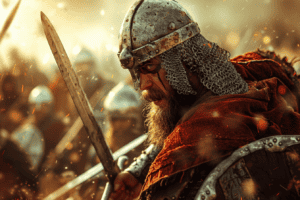In 793 CE, the Vikings launched a brutal assault on the Monastery of Wearmouth, marking their second strike on English soil.
The attack, driven by a desire for plunder and dominance, left a trail of destruction in its wake, ravaging the monastery’s buildings and renowned library.
The consequences of this raid were far-reaching, shattering the illusion of monasteries as safe havens and sparking fear and anxiety throughout the Christian world.
As the dust settles, the question remains: what drove the Vikings to target this sacred site, and how would the Anglo-Saxons respond to this brazen attack?
The Monastery of Wearmouth

In the seventh century, the monastery of Wearmouth, established by Benedict Biscop in 674, stood prominently on the south bank of the Wear River in northeastern England. This monastery, along with its twin, Jarrow, formed a significant cultural and spiritual hub in the region.
As a center of learning, Wearmouth attracted scholars from across the continent, housing an extensive library and scriptorium. The monastery’s architecture was inspired by the Roman style, with stone buildings and a church featuring a distinctive square tower. Its proximity to the River Wear facilitated trade and commerce, allowing the monastery to flourish economically.
The monks of Wearmouth were known for their skill in craftsmanship, particularly in metalwork and illuminated manuscripts. Under the leadership of Biscop, the monastery played a crucial role in spreading Christianity throughout the region, earning its reputation as a beacon of learning and culture.
The monastery’s prominence and wealth, however, made it an attractive target for potential invaders.
Viking Motivations and Tactics

Driven by a desire for plunder and a need to assert their dominance over the region, the Vikings set their sights on the monastery of Wearmouth, specifically targeting its wealth and cultural significance. As expert raiders, they’d honed their skills in naval warfare, using their sleek longships to navigate the North Sea and catch their enemies off guard.
The Vikings’ battle tactics relied on speed, surprise, and ferocity, allowing them to overwhelm their opponents quickly. Their warriors, clad in leather and iron, wielded fearsome weapons like axes, swords, and bows, which they used to devastating effect.
The Vikings also employed clever strategies to exploit their enemies’ weaknesses. They’d often launch a diversionary attack, drawing defenders away from the main target. Meanwhile, a smaller group of warriors would sneak into the monastery, seizing valuable assets and escaping before the main force arrived.
Destruction and Aftermath

The Viking raid on Wearmouth monastery left a trail of destruction, with buildings reduced to ashes and the once-peaceful community shattered by the brutality of the attack. The raiders ravaged the monastery, plundering its treasures and destroying its sacred artifacts. The monastery’s library, which housed precious manuscripts and historical records, was likely a primary target, and it’s believed that many valuable texts were lost in the blaze.
The aftermath of the raid was marked by chaos and despair. Many monks and villagers were killed or taken captive, and those who managed to escape were left to pick up the pieces and rebuild their shattered lives. The monastery’s buildings, which had stood for centuries, lay in ruins, a evidence of the ferocity of the Viking attack.
The raid also had a profound impact on the local community, sowing fear and mistrust among the people. The Wearmouth raid served as a stark reminder of the Viking threat, and it would take years for the community to recover from the devastating effects of the attack.
Impact on the Christian World

Shockwaves rippled through the Christian world as news of the Wearmouth raid spread, shattering the illusion of monasteries as safe havens. The attack on this sacred site, a symbol of Christian faith, sent a chilling message to the faithful: nowhere was truly secure.
The Viking raiders had demonstrated their ability to strike at the very heart of Christian England, sparking widespread fear and anxiety. Monasteries, once thought to be inviolable, were now seen as vulnerable to pillage and destruction. The clergy, traditionally seen as the guardians of faith and morality, were forced to confront their own powerlessness in the face of Viking aggression.
As the news of the raid spread, it’s likely that many Christians began to question the ability of their religious leaders to protect them from the heathen hordes. The psychological impact of the Wearmouth raid can’t be overstated, as it marked a significant turning point in the relationship between the Christian Church and the Viking raiders.
Anglo-Saxon Response and Repercussions

Following the Wearmouth raid, King Beornred of Mercia and Northumbrian leader Umbafa scrambled to mobilize their forces against the Viking invaders. The swift response aimed to prevent further pillaging and to safeguard their kingdoms. Beornred’s Mercian forces marched north, while Umbafa’s Northumbrian troops prepared to defend their territories. The Anglo-Saxon leaders recognized the need for a united front against the Viking menace.
The aftermath of the raid saw increased fortification and military preparedness across the region. The Northumbrian kingdom, in particular, strengthened its defenses, fearing another Viking attack. The Wearmouth raid also led to a re-evaluation of the Anglo-Saxon military strategy, with a greater emphasis on naval defenses and rapid response units.
Moreover, the raid marked a shift in the balance of power, as the Viking presence in England became a pressing concern for the Anglo-Saxon kingdoms. The Wearmouth raid served as a catalyst, prompting the Anglo-Saxon leaders to reassess their military preparedness and forge new alliances to counter the Viking threat.










Add Comment